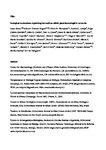Ecological mechanisms explaining interactions within plant–hummingbird networks: morphological matching increases towards lower latitudes
| dc.contributor.author | Sonne, J | |
| dc.contributor.author | Vizentin-Bugoni, J | |
| dc.contributor.author | Maruyama, PK | |
| dc.contributor.author | Araujo, AC | |
| dc.contributor.author | Chávez-González, E | |
| dc.contributor.author | Coelho, AG | |
| dc.contributor.author | Cotton, Peter | |
| dc.contributor.author | Marín-Gómez, OH | |
| dc.contributor.author | Lara, C | |
| dc.contributor.author | Lasprilla, LR | |
| dc.contributor.author | Machado, CG | |
| dc.contributor.author | Maglianesi, MA | |
| dc.contributor.author | Malucelli, TS | |
| dc.contributor.author | González, AMM | |
| dc.contributor.author | Oliveira, GM | |
| dc.contributor.author | Oliveira, PE | |
| dc.contributor.author | Ortiz-Pulido, R | |
| dc.contributor.author | Rocca, MA | |
| dc.contributor.author | Rodrigues, LC | |
| dc.contributor.author | Sazima, I | |
| dc.contributor.author | Simmons, BI | |
| dc.contributor.author | Tinoco, B | |
| dc.contributor.author | Varassin, IG | |
| dc.contributor.author | Vasconcelos, MF | |
| dc.contributor.author | O'Hara, B | |
| dc.contributor.author | Schleuning, M | |
| dc.contributor.author | Rahbek, C | |
| dc.contributor.author | Sazima, M | |
| dc.contributor.author | Dalsgaard, B | |
| dc.date.accessioned | 2020-03-11T16:04:43Z | |
| dc.date.available | 2020-03-11T16:04:43Z | |
| dc.date.issued | 2020-03 | |
| dc.identifier.issn | 0962-8452 | |
| dc.identifier.issn | 1471-2954 | |
| dc.identifier.other | ARTN 20192873 | |
| dc.identifier.uri | http://hdl.handle.net/10026.1/15445 | |
| dc.description | No embargo | |
| dc.description.abstract |
<jats:p>Interactions between species are influenced by different ecological mechanisms, such as morphological matching, phenological overlap and species abundances. How these mechanisms explain interaction frequencies across environmental gradients remains poorly understood. Consequently, we also know little about the mechanisms that drive the geographical patterns in network structure, such as complementary specialization and modularity. Here, we use data on morphologies, phenologies and abundances to explain interaction frequencies between hummingbirds and plants at a large geographical scale. For 24 quantitative networks sampled throughout the Americas, we found that the tendency of species to interact with morphologically matching partners contributed to specialized and modular network structures. Morphological matching best explained interaction frequencies in networks found closer to the equator and in areas with low-temperature seasonality. When comparing the three ecological mechanisms within networks, we found that both morphological matching and phenological overlap generally outperformed abundances in the explanation of interaction frequencies. Together, these findings provide insights into the ecological mechanisms that underlie geographical patterns in resource specialization. Notably, our results highlight morphological constraints on interactions as a potential explanation for increasing resource specialization towards lower latitudes.</jats:p> | |
| dc.format.extent | 20192873-20192873 | |
| dc.format.medium | Print-Electronic | |
| dc.language | en | |
| dc.language.iso | en | |
| dc.publisher | The Royal Society | |
| dc.rights | Attribution-NonCommercial-NoDerivatives 4.0 International | |
| dc.rights | Attribution-NonCommercial-NoDerivatives 4.0 International | |
| dc.rights | Attribution-NonCommercial-NoDerivatives 4.0 International | |
| dc.rights | Attribution-NonCommercial-NoDerivatives 4.0 International | |
| dc.rights | Attribution-NonCommercial-NoDerivatives 4.0 International | |
| dc.rights | Attribution-NonCommercial-NoDerivatives 4.0 International | |
| dc.rights.uri | http://creativecommons.org/licenses/by-nc-nd/4.0/ | |
| dc.rights.uri | http://creativecommons.org/licenses/by-nc-nd/4.0/ | |
| dc.rights.uri | http://creativecommons.org/licenses/by-nc-nd/4.0/ | |
| dc.rights.uri | http://creativecommons.org/licenses/by-nc-nd/4.0/ | |
| dc.rights.uri | http://creativecommons.org/licenses/by-nc-nd/4.0/ | |
| dc.rights.uri | http://creativecommons.org/licenses/by-nc-nd/4.0/ | |
| dc.subject | resource specialization | |
| dc.subject | forbidden links | |
| dc.subject | modularity | |
| dc.subject | phenology | |
| dc.subject | abundances | |
| dc.subject | pollination | |
| dc.title | Ecological mechanisms explaining interactions within plant–hummingbird networks: morphological matching increases towards lower latitudes | |
| dc.type | journal-article | |
| dc.type | Journal Article | |
| dc.type | Research Support, Non-U.S. Gov't | |
| plymouth.author-url | https://www.webofscience.com/api/gateway?GWVersion=2&SrcApp=PARTNER_APP&SrcAuth=LinksAMR&KeyUT=WOS:000562424400005&DestLinkType=FullRecord&DestApp=ALL_WOS&UsrCustomerID=11bb513d99f797142bcfeffcc58ea008 | |
| plymouth.issue | 1922 | |
| plymouth.volume | 287 | |
| plymouth.publication-status | Published | |
| plymouth.journal | Proceedings of the Royal Society B: Biological Sciences | |
| dc.identifier.doi | 10.1098/rspb.2019.2873 | |
| plymouth.organisational-group | /Plymouth | |
| plymouth.organisational-group | /Plymouth/Faculty of Science and Engineering | |
| plymouth.organisational-group | /Plymouth/Faculty of Science and Engineering/School of Biological and Marine Sciences | |
| plymouth.organisational-group | /Plymouth/REF 2021 Researchers by UoA | |
| plymouth.organisational-group | /Plymouth/REF 2021 Researchers by UoA/UoA06 Agriculture, Veterinary and Food Science | |
| plymouth.organisational-group | /Plymouth/Research Groups | |
| plymouth.organisational-group | /Plymouth/Research Groups/Marine Institute | |
| plymouth.organisational-group | /Plymouth/Users by role | |
| plymouth.organisational-group | /Plymouth/Users by role/Academics | |
| dc.publisher.place | England | |
| dcterms.dateAccepted | 2020-02-17 | |
| dc.rights.embargodate | 2020-3-28 | |
| dc.identifier.eissn | 1471-2954 | |
| dc.rights.embargoperiod | Not known | |
| rioxxterms.versionofrecord | 10.1098/rspb.2019.2873 | |
| rioxxterms.licenseref.uri | http://creativecommons.org/licenses/by-nc-nd/4.0/ | |
| rioxxterms.licenseref.startdate | 2020-03 | |
| rioxxterms.type | Journal Article/Review |



